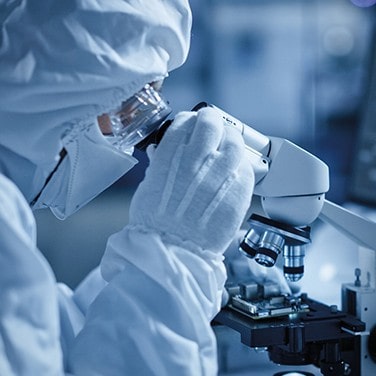The Basics of Cleanroom Upkeep
By Mike Howie.
Cleanroom upkeep is essential to protecting the quality of your finished products. In some cases, even one small contaminant can be destructive, potentially costing millions of dollars in wasted effort and material.
Every cleanroom is unique — built for a specific purpose and subject to specific guidelines. Your cleanroom upkeep routine should be just as unique, designed with your physical space and applications in mind. There are, however, general guidelines that can help you build the right routine for your needs. Broadly, there are four parts to cleanroom upkeep:
- Prevent as much contamination from entering the cleanroom as possible
- Clean as well as you can using the right tools for your environment
- Monitor surfaces and the air for contaminants
- Validate that your routine is keeping the environment adequately clean
What are the tips for keeping your cleanroom clean?
Keep Contaminants Out
If you start with a clean cleanroom, upkeep is much simpler.
Anything entering the cleanroom, including people, is the largest source of potential contamination. Restricting items like cardboard and using using sticky contamination control mats to remove particles from shoes can help prevent contaminants from entering the cleanroom in the first place. Take care when introducing any new people or items to the cleanroom. People should be wearing the right garments and donning them properly.
Use the Right Cleaning Products
Your choice of cleaning products is important because lower-quality products can introduce more contamination into your cleanroom. Keep in mind that there are always new mops, wipers, disinfectants, and other products entering the market and what you’ve been using may no longer be in line with best practices. String mops, for example, effectively spread disinfectant but don’t reliably remove contaminants. A cleanroom mop should help disinfect surfaces and successfully remove contaminants.
While these cleaning products can be more expensive, ask yourself how much you’re willing to pay for peace of mind. If a 0.5µm particle could ruin a 1 million USD product, purchasing effective cleaning products is likely worth the investment.
Be Wary of Laundering Garments and Supplies
In some situations, laundering and reusing garments, mops, or other supplies can effectively reduce costs. But it also carries a risk: laundering may not remove all contaminants. If contaminants remain in a cleaning product after laundering, there’s a risk that those contaminants could be reintroduced into the cleanroom. While using new cleaning products every time may be more expensive, it helps reduce the risk of introducing contaminants while cleaning.
Clean Before You Disinfect
Sterile is not the same as clean. While disinfecting may render contaminants inert, sterile contaminants can still adulterate your final product. By removing contaminants before disinfecting, you can be more confident that your cleanroom is truly clean.
Remain Vigilant
Continuously monitor surfaces and the air in your cleanroom for particles, viables, volatile organic compounds, and any other potential contaminants. By tracking conditions within your cleanroom, you’ll have a better idea of the challenges you face and can evolve your cleaning procedures as needed.
After a while, you can analyse the collected data to identify any trends. Any increase in contamination is worthy of investigation — even if your cleanroom is still within defined limits.
Follow Applicable Guidelines
Multiple organisations publish guidelines for building, operating, and maintaining cleanrooms, including the Institute of Environmental Sciences and Technology (IEST), the Parenteral Drug Association (PDA), ASTM International, and the United States Pharmacopeia (USP). In some instances, these organisations even provide detailed direction on how to clean. Research which guidelines apply to your cleanroom and follow their guidance.
Cleanroom upkeep should be a constant priority and a daily consideration. By keeping your cleanroom as clean as possible at all times, you’re protecting the quality of your finished products.
Mike Howie is a Thermo Fisher Scientific content copywriter.

